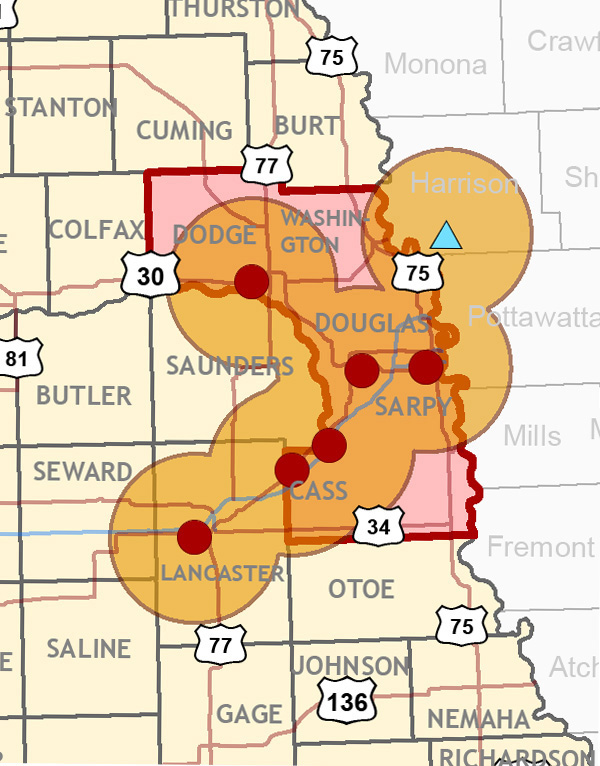
By Sarah Browning, Extension Educator
In case you missed it, on Thursday, Aug. 22, Nebraska Department of Agriculture (NDA) confirmed the discovery of emerald ash borer (EAB) adults in Lancaster County. Adult beetles were caught in a monitoring trap set up northwest of Pioneers Park.
An ash tree in Fremont, Neb. with signs and symptoms of EAB infestation has also been reported, although confirmation of the insects is not yet completed. EAB’s continued spread in Nebraska is not a surprise. Since its detection in a Detroit, Mich. suburb in 2002, the insect has spread to 33 states and the Canadian provinces of Ontario, Quebec and Manitoba.
NDA has updated the EAB Detection Map showing the newest confirmations and recommended 15-mile treatment zones (see above). Later this year, once the adult beetle flight period has ended, NDA will adjust the quarantine areas. The most current EAB confirmation map can always be found on the Nebraska Forest Service EAB website, https://nfs.unl.edu/nebraska-eab.
How does this new confirmation affect Lincoln and Lancaster County homeowners?
15-MILE TREATMENT CONSIDERATION ZONE
The Nebraska Forest Service recommends not beginning to treat until your property is within 15 miles of an EAB-confirmed site. Treating trees outside of the 15-mile zone provides little or no benefit to trees, yet exposes humans and the environment to pesticides, wastes money and, in the case of trunk injections, causes unjustified tree damage.
The new confirmation puts the majority of Lincoln and Lancaster county within the 15-mile zone.
All ash species are at risk, including white, green and black ash. Popular ash cultivars ‘Autumn Purple,’ ‘Marshall’s Seedless’ and ‘Patmore’ are susceptible. Mountain ash is not affected by EAB, because despite its common name it is not a true member of the ash family.
WHAT IS THE BEST TIME OF YEAR TO TREAT?
Trees take in the systemic insecticides used against EAB best from April through early June. Research has shown that fall applications, although discussed on some product labels, require double the amount of product to provide the same level of control as spring applications. Considering the slow-moving nature of EAB, waiting until spring is the best choice even if you live right next to Pioneer’s Park.
But not all ash trees should be saved. If a tree is in a poor location, possibly too close to your house’s foundation, why spend money to treat it? Treatments are not like immunizations, they don’t protect the tree forever. Trees require treatment every 1 or 2 years, depending on the chemical used, to provide continued protection.
If a tree is already in bad health for reasons unrelated to EAB, it’s unlikely the tree will survive the treatments.
The better long-term solution is to allow these trees to die or remove them and replant with resistant species. For help in deciding whether your tree is a good candidate, review “Selecting Trees for Emerald Ash Borer Treatments,” http://nfs.unl.edu/Selecting%20ash%20for%20EAB%20trt%20full%20sheet.pdf.
WHAT TREATMENTS CAN BE USED
Two main types of treatments — injection or soil drench — can be used depending on the size of the tree. But with either type of treatment, the systemic chemicals used are taken in best by the trees in spring and early summer.
In large trees, 45-inch circumference and over measured at 4 feet above the ground, injection of systemic insecticide provides the best control. But injections have drawbacks — specifically, they cause damage to the tree. Most are applied by drilling holes into the tree’s trunk, which opens up the trunk to insect pests and decay fungi. Drilling may also break through internal barriers, created by the tree within the trunk, to wall off internal decay. Breaking this barrier allows decay to spread into healthy wood. In addition, the pesticide itself can cause internal damage that may accumulate over years of repeated injections and potentially kill the tree, even if the pest is controlled.
Small trees, under 45-inch circumference, can be treated with soil applications. Soil drench products are easy to apply, don’t require any special equipment or wounding of the tree and provide good control on young trees.
THERE’S PLENTY OF TIME TO TREAT
EAB does not kill trees quickly — it takes a few years of continued infestation before trees begin to decline. Often insects have been in a tree for 2–3 years before signs of decline are noticed and 1–2 more years before the tree dies completely. This is another reason homeowners shouldn’t rush to treat trees this fall, but instead wait until next spring to begin treating healthy trees.
If treatment begins when 30 percent or less canopy dieback has occurred, an otherwise healthy vigorous tree can usually be expected to fully recover. Trees with over 50 percent canopy dieback, however, are less likely to recover.
FOR MORE INFORMATION
The Nebraska Forest Service emerald ash borer website at https://nfs.unl.edu/nebraska-eab has many resources, including:
• EAB: Guidelines for Nebraska Homeowners, http://nfs.unl.edu/documents/EAB/EABhomeownerfullsheet2012Oct.pdf
• Emerald Ash Borer Treatment Options, https://nfs.unl.edu/documents/EAB/EABTrunkInjectionTmtOptions.pdf